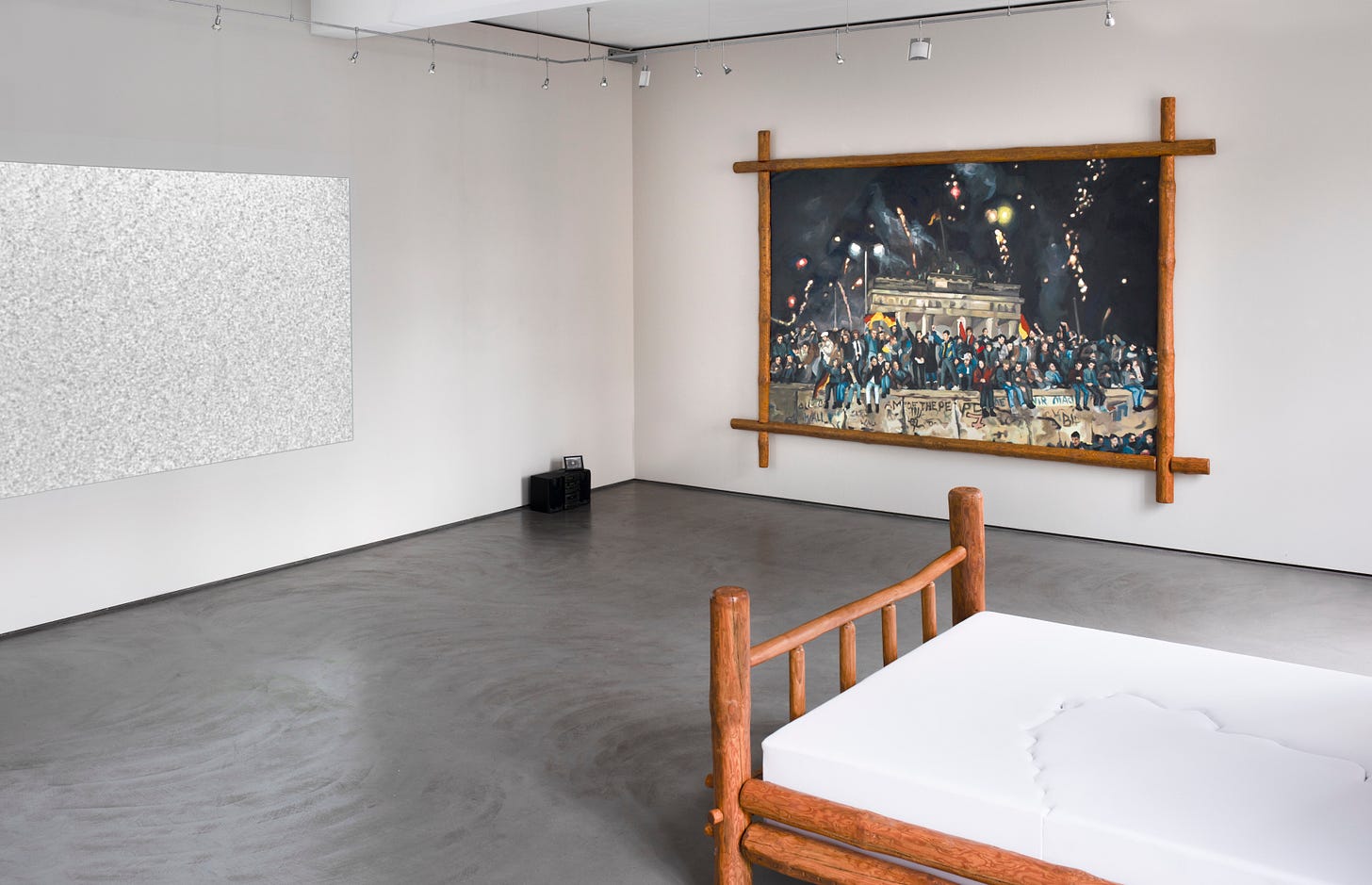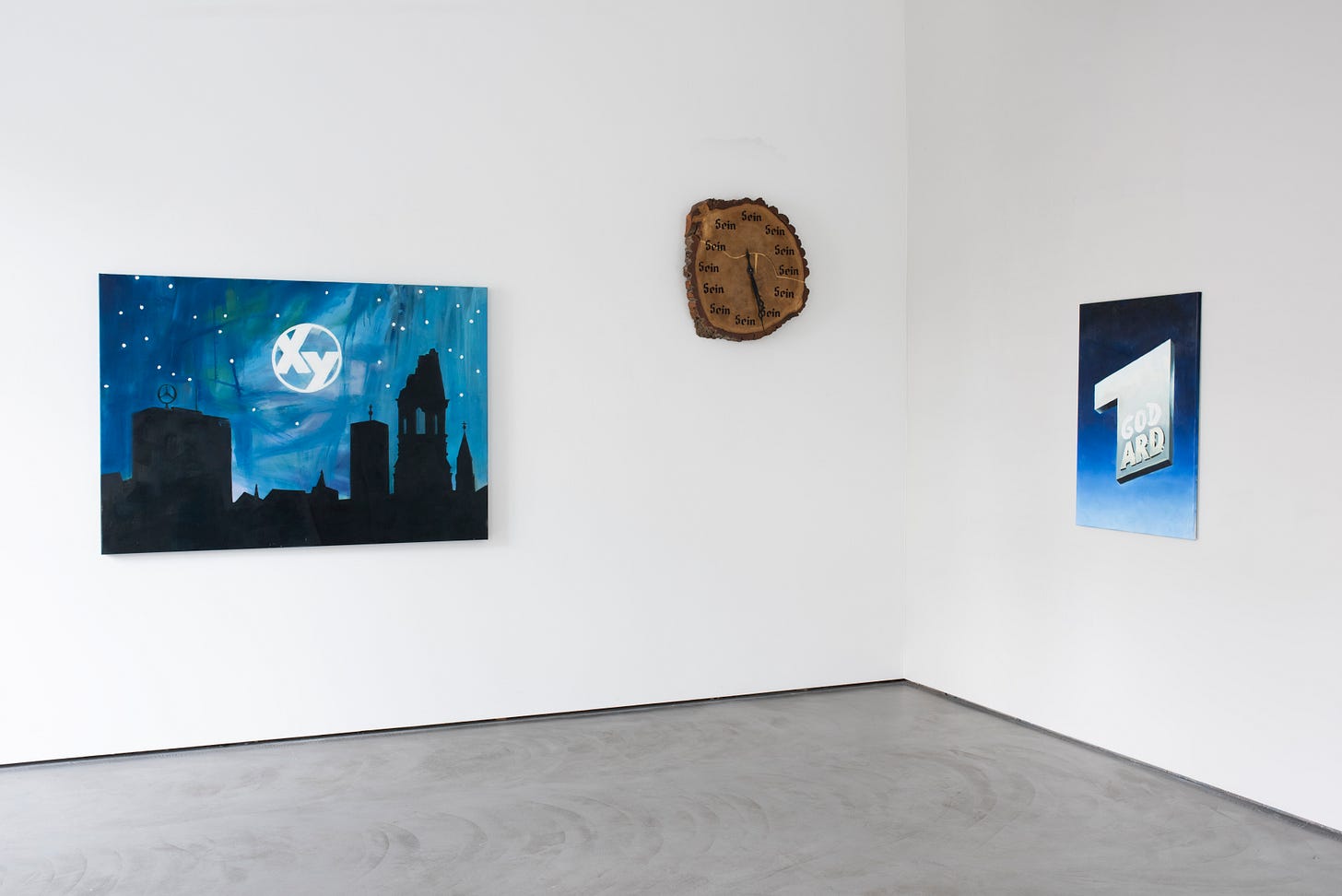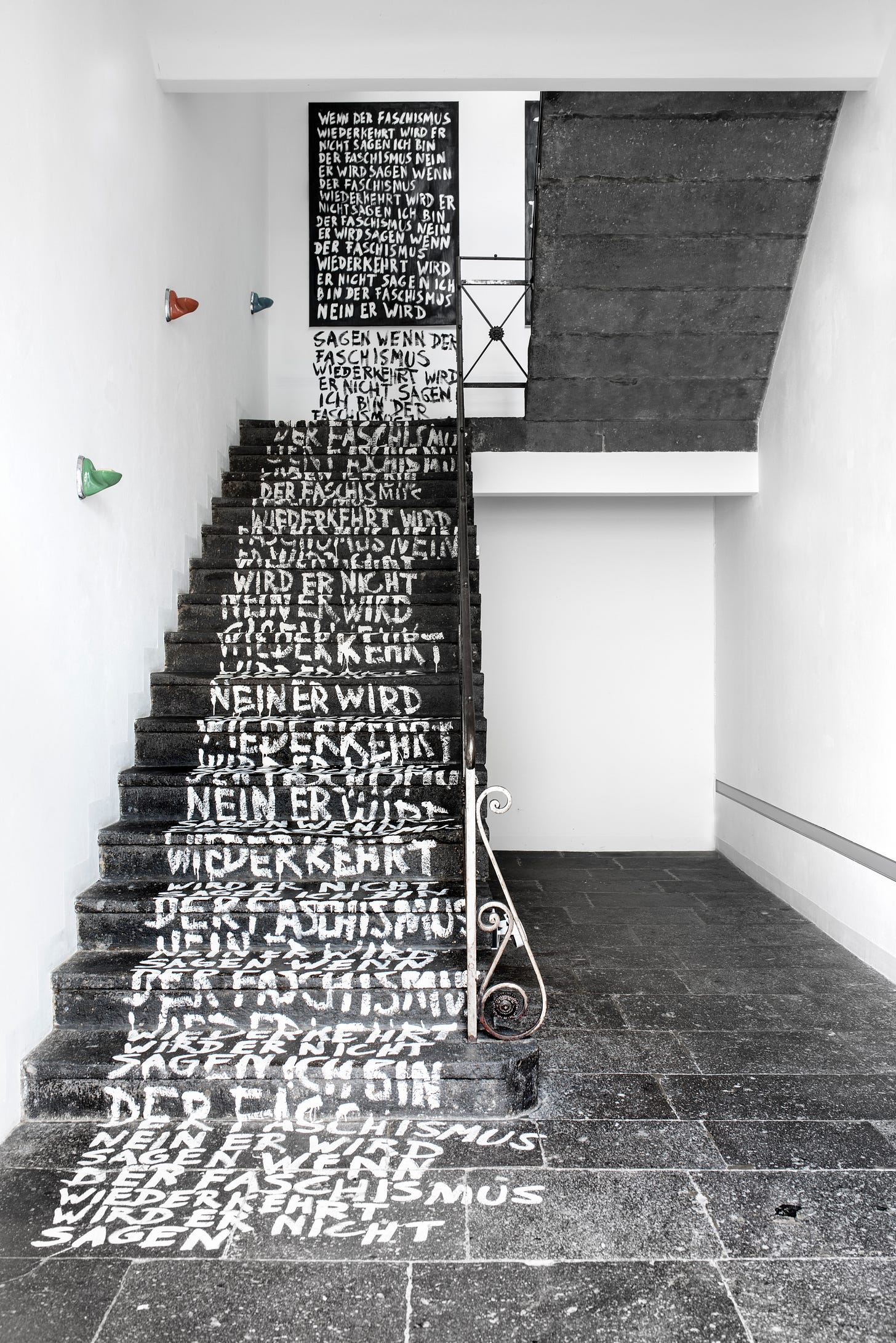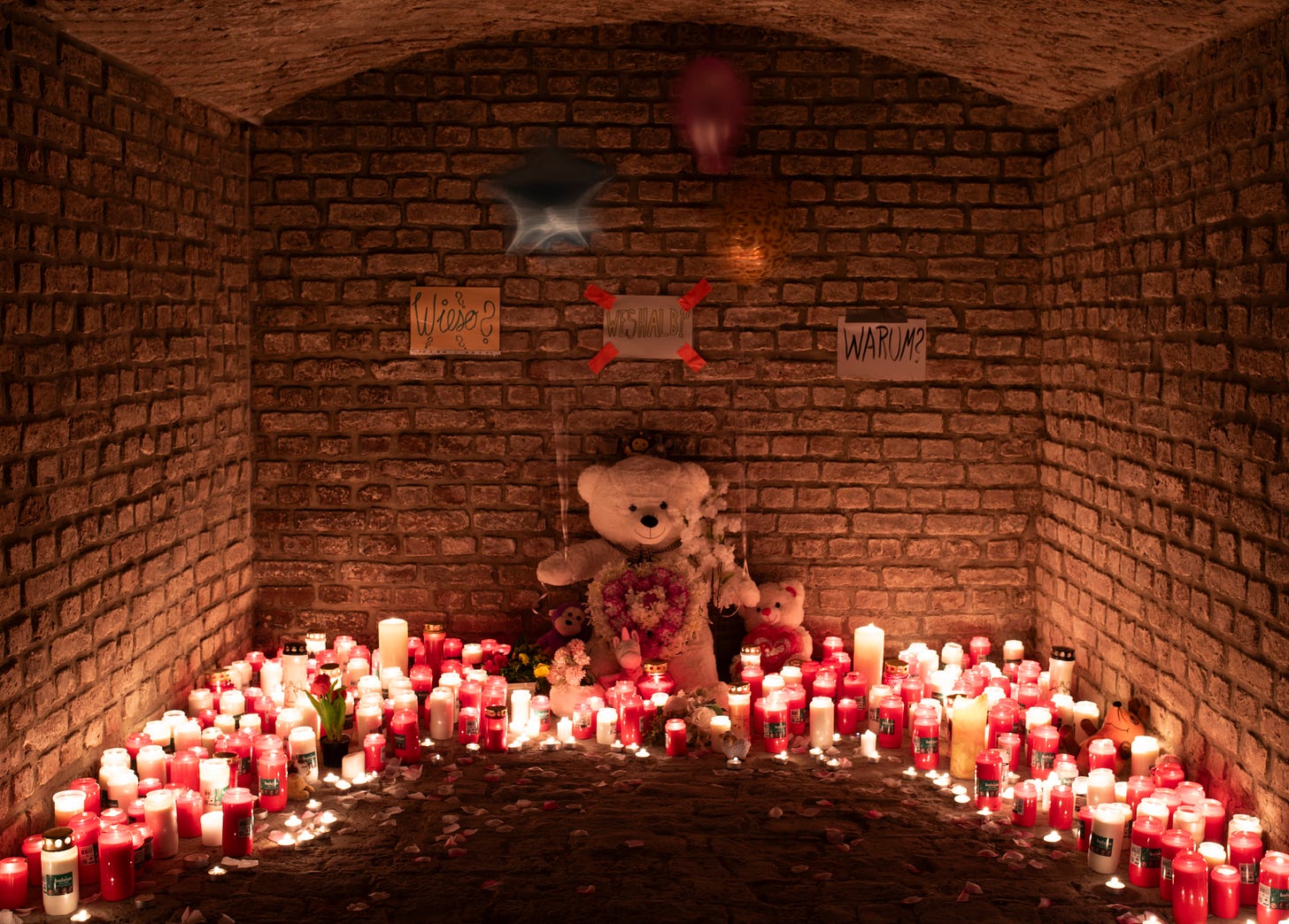My Dear Mr. Singing Club: Nicholas Warburg at Galerie Judith Andreae
Nicholas Warburg (Millennial, German) took me on a dark path through German History...but does anyone besides Nicholas know where he's going with this?
I love the way Nicholas pulls a Pepe Silvia, connecting all the dots on how the aura of Fascism persists in the tiniest niches of Germany to this day. Gallery Director Katja told me about her reasoning for making this show here in Bonn, and it totally makes sense: The former national capital, its sleepy bourgeois attitudes, the nationwide political turn to conservatism… Time and place fit perfectly to bring out some of Nicholas’s energy. Call me Charles Dickens the way I went in with Great Expectations. But did the show meet them? Did the show and my expectations actually say Hi to each other at some point?
Home Sweet Home
There’s a floor mat with the SMPTE color bars on the threshold to the first room. You know, the colored stripes you’d see on older TVs when the signal wasn’t working. In a flickering font, Nicholas wrote ES GEHÖRT ZUR MORAL NICHT BEI SICH SELBER ZU HAUSE ZU SEIN [IT IS PART OF MORALITY NOT TO BE AT HOME WITH YOURSELF]. I ask Google. Turns out the philosopher Theodor Adorno (1903-69, German) said that.1 I read the whole passage of that quote to get some context. Homeboy has the most cluttered argumentative structure, I guess I need to read the whole book to get it. Suhrkamp published the book in which the phrase first appeared. We’ll get to that later.
So I get into the first room. There’s a bed with two nightstands, a sound system, three paintings, and a clock. The bed and one painting’s frame are made of wooden sticks, it’s giving youth hostel vibes. Borderline furniture I’d see in a @sveamaus post. The sticks at the bed’s headboard cross like an “x” and a “y” (we’ll get to those letters in a minute). No pillows. No blankets. Just a plain white mattress. Stitches cut into the fabric, creating an outline that fairly resembles the division of Eastern and Western Germany. You could do such a Millennial-coded newspaper caricature with the former borders if you applied those Her side & His side blanket visuals.
Grainy image noise suggesting that the projector is bugging fills the wall opposite of the bed. There was a sound that I can’t quite remember. Something like a low hiss. Writing this review, a phrase plopped into my mind: The Revolution will not be televised. It surely won’t if we get Wolfram Weimer as Minister of Cultural Affairs. To the left, the painting titled Fernsehen ist Faschismus [(Watching) Television is Fascism] (2024) depicts an old school version of the ARD channel logo. Nicholas wrote GOD on top of ARD, which you could pronounce as Godard, like the filmmaker Jean-Luc Godard (1930-2022, French-Swiss). I guess I’m supposed to know some more than his name because all I get is a lil pun.
First nightstand: Plain sunnies. I must confess I didn’t look close enough: The pictures revealed an engraving of 1 BRD German Mark on each lens. I don’t get it. On the other nightstand — an open book with an embedded Flutschfinger icicle. Brings me back to ye good ol’ days at the water park with some fries and Langnese ice cream. I look at the book cover: It’s Martin Heidegger (1889-1976, German). No he didn’t. I physically rolled my eyes thinking please don’t be that guy, Nicholas.
If I know a little something about Marty’s philosophy, it’s that
a) his theories are based around complex understandings of Sein [being], Ding [thing], and Zeug [stuff]
b) he was fascist friendly.
That’s the little context that helped me with the wooden clock titled Sein-und-Zeit-Uhr [being-and-time-clock] (2023). Instead of numbers on the dial, Nicholas wrote Sein in the Nazi’s beloved Tannenberg font. Similar to the bed mattress, a crack runs through the surface. But that icecicle book? I have no clue.
So far, I need a PhD in European Philosophy, Film History, and Literature. Did I miss anything? If anyone comes at me with some diT Is AbEr GrUnDwISsEN frÄulEiN — fuck y’all. Nothing is as subjective as what constitutes common knowledge. One thing is for sure: This one’s for the Germans. I’m facing the same problem I faced with my Frenzy Höhne (Millennial, German) review. How do you explain something inherently local to an international context without getting lost in translation? Especially if you don’t casually know all the references?
Going Down Memory Lane
The other painting. People sit and stand on a graffiti-sprayed wall with the Brandenburg Gate and fireworks behind them. That’s obviously 1989. But Nicholas engraved the year 1945 into the lower part of the frame and chose that year as the title. An odd contrast. 1945 and 1989. Both years marked a beginning and an end. Not everybody was happy when the DDR crumbled and I guess even more were pissed at the dissolution of the Nazi regime (cause come on, ain’t no way everybody’s grandpa was in the Resistance). Is that the parallel? Idk dawg, that would be bland.
One more painting. A black city skyline against a messily painted blue night sky. I can make out a tower ruin, a church, some smaller buildings, and another high-rise with the Mercedes-Benz logo on top. The logo is taller than the church crosses. Capitalism as religion? Hm. A white XY logo lights up the sky like the Bat-Signal.
Let’s get to the Xs and Ys in the show’s title AKTENZEICHEN XY UNERLÖST [FILE NUMBER XY UNREDEEMED]. It’s a reference to the German True Crime show Aktenzeichen XY … ungelöst, which has been running since 1967. This is a moment where I don’t feel German enough because I thought it’s a reference to the American mystery case show X-Factor: Das Unfassbare [original: Beyond Belief: Fact or Fiction] which I used to watch as a kid and get scared shitless. In Aktenzeichen XY … ungelöst, viewers can call in to give hints on the unsolved cases presented and according to their data, almost 40% of the cases got solved that way. Can we just let that sink in for a moment?
Moreover, the press text explains that the TV show fueled a culture of distrust and hostility: Everybody can be your enemy. Also, it’s giving raising lil snitches. So who is that shiny XY logo in the sky for? Unlike Gotham, Germany can’t count on a Batman to save the day.
I walk upstairs. Nicholas positioned one painting at the end of the first flight of stairs. He wrote in German: When fascism returns, it won’t say I’m fascism, no, it will say when fascism returns… infinitely extending over the black canvas, onto the wall, and down the stairs. I saw this work already at the group show Keine Akten nirgends in Düsseldorf and it still bothers me. Not because of its content but because of the execution. I generally dislike writing on canvas if the text itself is the whole point. Like, the contained text would already be a dope title for a work. What does it being a painting add to the concept? You can just write all that on the wall, or start on a poster. As I already said in Frenzy’s review, I feel like artists tend to use painting as a sales pretext in such cases, not because it conceptually adds to the work.
The same applies to the painting Titelbild 34 (2025) with the phrase Unbehagen in der Suhrkamp Kultur [Unease in the Suhrkamp culture]. Interesting phrase, why as a painting, though? But more importantly: Is Nicholas the Simpsons or why does he predict everything scarily accurately? Journalists recently revealed that the former Suhrkamp Head Siegfried Unseld (1924-2002, German) was a member of the NSDAP Party…
I’d cut Nicholas some slack for Titelbild 32 (2024), which is the national flag of Germany, consisting of the phrase “Ich darf nicht lügen” [I must not lie] infinitely written in Black, Red, and Yellow on a canvas. Sure, post Jasper Johns (Silent Generation, US-American), you need a good reason to pull a flag-on-canvas situation, but the phrase repetition fits the historically self-punishing, discipline-oriented mindset of German culture. And just like a kid who has to write their misdemeanor on the chalkboard, can you ever be sure that Germany learned its lesson?
So many questions…
Finally — the basement. Before descending the stairs, I see another text painting with a question in German: “Did Reinhold Messner eat his brother?” Now who the fuck is that again? Shit sounds like a BILD Zeitung headline. I turn to Wikipedia. He’s the Mount Everest Guy. I remember seeing his biopic years ago. His brother died on a joint climbing expedition. Ok… so now what?
Down in the basement, there’s teddy bears with balloons and candles. Although Nicholas clearly stages a memorial here, I don’t see any clues as to what exactly he’s commemorating. Is it the death of Reinhold Messner’s brother? If so, why? Or is it a memorial for all my attempts at understanding the point of this show that Nicholas lays to rest here?
The words Wieso?, Weshalb?, and Warum? — which all simply translate into “Why?” — are written on simple paper sheets attached to the wall, each why in different handwriting. A nuance that’s lost in translation is that there’s a German saying that goes “Wieso, weshalb, warum — wer nicht fragt, bleibt dumm,” translatable more or less into “those who don’t ask why stay dumb”. I know, it doesn’t hit the same in English. But is that the moral of the story? Keep asking tough questions?
What does Nicholas convey with this show? What is it beyond Germany being a böser Bub to this day? If this were an episode of Aktenzeichen XY … ungelöst, I’d be confronted with some loosely connected clues that inevitably get lost in intellectual references going over my head. There is no hot trail. What’s more important? Solving the case or showing off?
Nicholas Warburg: AKTENZEICHEN XY UNERLÖST, until May 10, 2025, at Galerie Judith Andreae, Bonn.
Galerie Judith Andreae
Paul-Kemp-Strasse 7D
53173 Bonn
Website
Instagram: @galeriejudithandreae @nicholaswarburg
What do you think of this true crime episode? Let me know in the comments. As always, I’d appreciate your liking and sharing this post. Thank you!
See you soon!!!
Jennifer
The Gen Z Art Critic
Theodor Adorno: Minima Moralia. Reflexionen aus dem beschädigten Leben, Suhrkamp 1951, p. 18 (PDF p. 16), FULL PDF LINK









